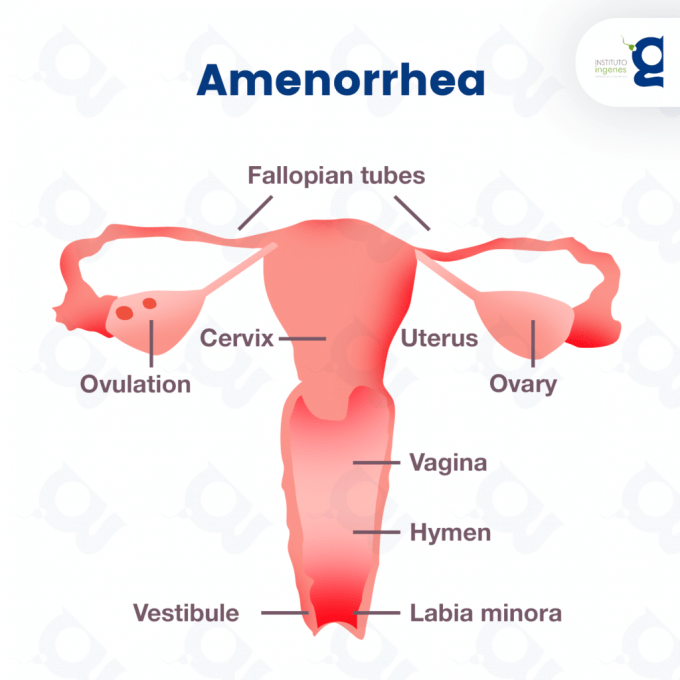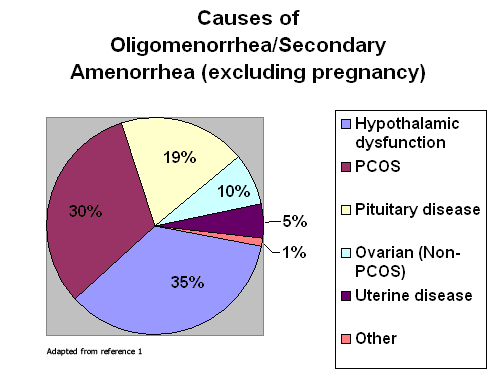Amenorrhea is the absence of menstrual periods. This is a sign of an underlying medical condition and the accompanying symptoms vary depending on its causes.
Treating the condition causing amenorrhea generally resolves this symptom and should always be accompanied by advice for a healthy lifestyle, which in some cases can help restore menstrual periods and, depending on the causes, even fertility.
What is amenorrhea?
Amenorrhea is the absence of menstrual periods and is classified as:
- Primary amenorrhea This is when a woman over 16 years old has not had her first period.
- Secondary amenorrhea This is the most common and refers to the absence of menstruation for three months or more in a woman who used to menstruate regularly. The most common cause of secondary amenorrhea is pregnancy, followed by polycystic ovary syndrome.
Amenorrhea is a symptom of an underlying medical condition and affects between 2 and 5 percent of American women. However, it is normal for women under 16, over 45, or pregnant women not to menstruate.

Main symptoms of amenorrhea
Amenorrhea is not a disease but a sign of an underlying medical condition, and therefore the accompanying symptoms vary depending on its causes.
These can include:
- Delay in the appearance of secondary sexual characteristics (pubic hair, breast growth)
- Chronic pelvic pain
- Pain during sexual intercourse
- Hot flashes or flushes
- Decreased libido
- Irritability and frequent mood swings
- Galactorrhea or the production of breast milk not related to breastfeeding
- Headache or sharp head pains
- Visual disturbances
- Weight gain or loss
- Swelling of the face, hands, and feet
- Decreased or increased heart rate
- Depression
- Difficulty concentrating
- Nervousness and anxiety
- Trembling hands
- Hirsutism or unwanted hair growth
- Acne
- Skin spots
- Dry skin and brittle nails
- Infertility
If you have any of these symptoms, it is important to consult a fertility specialist as soon as possible to avoid complications.
Causes of Amenorrhea
Primary amenorrhea can occur in the hypothalamus, pituitary gland, or ovaries and is generally due to hormonal imbalances.
Similarly, it can be caused by abnormal development of the female reproductive system or the presence of an unperforated hymen that makes it difficult to eliminate menstrual flow.

On the other hand, secondary amenorrhea often occurs in patients who have undergone one or more uterine curettages, as well as due to hormonal imbalances (the most common being polycystic ovary syndrome) and the use of oral contraceptives or intrauterine devices (IUDs).
Secondary amenorrhea can also be caused by stress, anxiety, depression, eating disorders, excessive exercise, weight gain or loss, use of psychotropic drugs, and cancer treatments such as chemotherapy and radiation therapy.
Some of the main conditions causing amenorrhea are:
- Pelvic adhesions
- Anovulation
- Premature ovarian failure
- Hyperprolactinemia
- Thyroid disorders
- Uterine malformations
- Uterine fibroids
- Obesity
- Insulin resistance
- Polycystic ovary syndrome
- Uterine synechiae
How are the causes of amenorrhea diagnosed?
In addition to a pelvic exam and analysis of the patient’s medical history, procedures for diagnosing the causes of amenorrhea may include:
- A blood test to determine levels of ovarian hormones (estrogen and progesterone) pituitary hormones (luteinizing hormone, follicle-stimulating hormone, thyroid-stimulating hormone, and prolactin), and hypothalamic hormones (gonadotropin-releasing hormone) and rule out conditions such as anovulation, premature ovarian failure, hyperprolactinemia, thyroid disorders, and polycystic ovary syndrome.
- A gynecological transvaginal ultrasound, during which the doctor inserts a probe into the woman’s vagina to examine her reproductive organs. This is a non-invasive method that allows the doctor to rule out malformations, fibroids, and uterine synechiae, which could hinder the elimination of menstrual flow.
- A magnetic resonance imaging (MRI) or brain computed tomography (CT) scan if a pituitary tumor or adenoma is suspected.

Once the causes of amenorrhea are determined, treatments may include:
- Use of medications to restore the hormonal balance of the body and correct conditions such as insulin resistance in patients with polycystic ovary syndrome.
- Ovulation induction, for which drugs such as clomiphene citrate and gonadotropins are often used, and their administration must be carefully monitored by a specialist. This treatment is particularly useful when the woman is under 35 years of age.
- If medications are not enough, the best option is In Vitro Fertilization (IVF), which makes it possible to select the best quality eggs for subsequent fertilization and implantation in the woman’s uterus.
- When the woman does not have viable eggs, in vitro fertilization with egg donation offers success rates of up to 60 percent.
- In a limited number of cases, it is necessary to carry out surgical treatments to remove pituitary tumors, normalize the hormonal environment of the ovaries, or remove obstacles that hinder the elimination of menstrual flow and hinder the normal development of pregnancy.
- Treatment of the condition causing amenorrhea usually resolves this symptom and should always be accompanied by advice for a healthy lifestyle, which in some cases can help restore menstrual periods and, depending on the cause, even fertility.
Finally, it is important to mention that for some women with amenorrhea, achieving a pregnancy may not be possible even with the most advanced treatments. In these cases, adoption or surrogacy may be viable alternatives to consider.
In summary, amenorrhea is not a disease but a symptom of an underlying medical condition, and its causes can vary greatly. Therefore, it is important to seek medical advice if you experience any symptoms of amenorrhea, as early diagnosis and treatment can greatly increase the chances of achieving a successful pregnancy.

